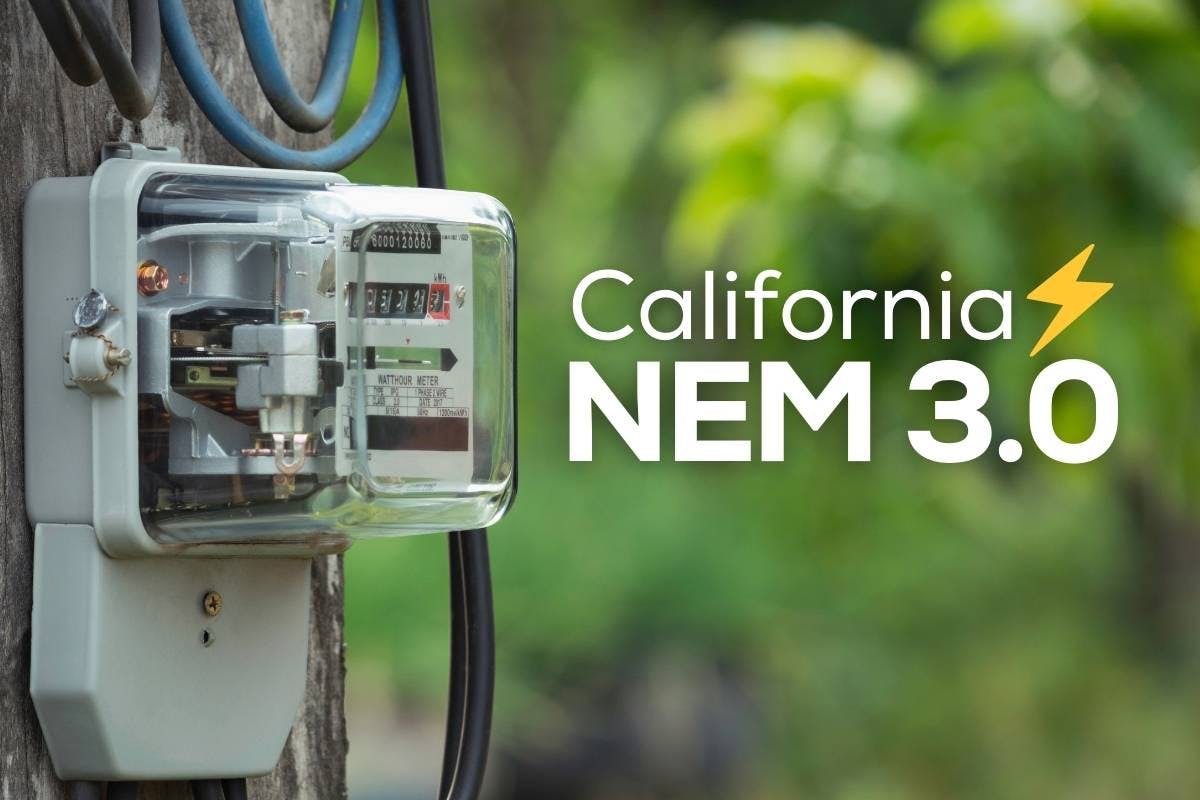Learn About NEM 3.0: California’s Solar Net Billing Program
Last edited

Author
Andrew Blok
Electrification and Solar Writer and Editor

Editor
Ryan Barnett
SVP, Policy & New Market Development

California is a leading solar state, especially for homeowners. That’s largely thanks to high electricity prices and historically strong incentives, which can lead to significant solar savings.
But in 2023, California changed its net metering policy, ushering in new regulations, commonly called Net Energy Metering (NEM) 3.0, that would cut the value of solar electricity sent back to the grid. Now, you save the most if you use as much of the solar electricity you generate as possible.
The immediate impact was a rush of installations before NEM 3.0 took effect, followed by a significant drop in installations. If you’re thinking about going solar now, here’s what you need to know about how it affects your home solar panels and battery storage.
See how much you can save by going solar with Palmetto
NEM 3.0 Key Points
NEM 3.0 is California’s net billing tariff policy for solar that dictates how excess solar energy is credited to homeowners. Here are some quick takeaways for the program.
- Consuming solar immediately in the home rather than exporting to the grid, and avoiding 4 to 9 p.m. on-peak usage, maximizes savings value under NEM 3.0.
- NEM 3.0 aims for an approximate payback period of nine years with or without a battery. This will vary depending on your system size, consumption habits, and system cost.
- NEM 3.0 only applies to California’s three main utilities: Pacific Gas & Electric (PG&E), Southern California Edison (SCE), and San Diego Gas & Electric (SDG&E). Municipal and cooperative utilities may adopt their own policies. Los Angeles Department of Water & Power offers 1-to-1 net metering.
What is Net Energy Metering?
Net energy metering is a billing system that allows solar system owners to earn credits from their utility for the excess solar energy their panels generate and add to the electric grid. These credits are often used later to offset the cost of electricity that solar owners pull from the grid when they need more power than what their panels produce, like at night. Net metering makes all the electricity solar panels produce valuable, not just what’s used on site. Where NEM policies are in place, solar owners can save much more on their energy bills.
While the value and structure of net metering programs vary by state and utility, both solar owners and utility providers benefit from this structure by allowing homeowners to save on their monthly electricity bills and allowing utilities to sell the excess electricity to neighbors, reducing demand for traditional power generation.
Under a traditional net metering structure, a utility would credit you for electricity you send back to the grid at the retail rate. Producing one kilowatt-hour of electricity would help offset one kilowatt-hour of your consumption, whether you actually used what you produced or not.
Under NEM 3.0, the policy is now technically net billing, which provides a lower-than-retail rate for the electricity you send to the grid. It is similar to net energy metering in that any solar power produced and consumed immediately in the home offsets electricity from the utility at the higher retail rate, but anything sent to the grid is worth less.
How California Homeowners Can Earn Electric Bill Credits With NEM 3.0
NEM 3.0 has been around for over a year now but can still cause some confusion. Here’s how it works.
Net billing, not net metering
Under NEM 3.0, California’s three main investor-owned utilities — PG&E, SCE, and SDG&E — will no longer offer net metering in the traditional sense; rather, solar customers will be eligible for net billing.
Net billing is a bit different in that your excess energy is “sold” to the utility at specified export credit rates. Under California’s NEM 3.0, the export credit is valued at the hourly avoided-cost rate, the price the utility would otherwise pay to produce the same power itself or to purchase it from a power plant.
Net billing provides a dollar value based on the wholesale rate of electricity for the month and hour the solar energy is sent to the grid. In California, the avoided-cost rate is on average 75% lower than the average retail rate (the price consumers pay for electricity from their utility) of over 30 cents/kWh in 2023. Wholesale prices for goods are almost always lower than their retail prices. The utility provides a service by powering the home every moment solar is not producing and so does not credit exports at retail prices.
NEM 3.0 does not apply retroactively, meaning homeowners who have already gone solar under NEM 1.0 and 2.0 will retain their current net metering structure. (This is called ‘grandfathering’.) Should they wish, NEM 1.0 and 2.0 customers may also purchase a battery or choose to modify their solar system by up to 1 kW or 10%, whichever is less, and stay within their current rate structure. Anything above a 10% change will push customers into NEM 3.0.
See how much you can save by going solar with Palmetto
Hourly export credits and adders
Under NEM 3.0, all exports to the grid (i.e. excess solar) will be priced using an Avoided Cost Calculator (ACC). In a nutshell, every hour, day, week, and year, the avoided-cost rate changes, averaging around 4 to 8 cents/kWh. It can range from as high as $3.50/kWh to as low as $0/kWh. Average export rates in the ACC will gradually increase over time just as retail rates and wholesale prices of power do.
There are also ACC Plus Adders, which are bonus adders to the export credits for California customers who go solar within the first five years of NEM 3.0. Essentially, the ACC Plus Adders offer more cents per kWh to solar customers to achieve the CPUC’s targeted payback period of nine years. These boosted rates will gradually decline over the next five years, and customers who install solar within this timeframe should have these boosted rates reflected on their electricity bills for the next nine years after they go solar.
In PG&E, the ACC Plus Adders for those who interconnect (i.e. are granted permission to operate from their utility) in the first year of NEM 3.0 is 2.2 cents/kWh, SCE is 4 cents/kWh, and SDG&E is zero. SDG&E customers are excluded from the adders, because with reasonable pricing and production assumptions, the payback is already shorter than nine years without adders. Low-income residents, which includes customers with a California Alternate Rates for Energy (CARE) or Family Electric Rate Assistance (FERA) plan, as well as tribal and disadvantaged communities, will receive higher adders.
Differentiated time-of-use (TOU) rates
To further reduce grid shortfalls and reliance on fossil fuels, NEM 3.0 also uses “high differential” TOU rates — also called electrification rates. These are still time-of-use rates, but different in that they have much higher prices during times of high demand on the grid, and much lower prices during periods of low demand.
This could promote home electrification and the use of battery storage to shift the time when most homes use a majority of their electricity, smoothing out the demand curve.

Credit: US Energy Information Administration
These rates include a monthly Grid Participation Charge of around $14 to $16 rather than the traditional Minimum Monthly Bill.
Currently, the TOU rates eligible with NEM 3.0 are:
- PGE Eligible Tariff: E-ELEC
- SCE Eligible Tariff: TOU-D-PRIME
- SDGE Eligible Tariff: EV-TOU-5
Each TOU rate has on-peak hours of 4 to 9 p.m. every day. To maximize solar savings, NEM 3.0 customers will want to consider shifting some of their consumption to the morning and early afternoon when their panels are producing the most electricity. Shifting consumption of controllable loads will reduce the on-peak charges and minimize solar exported to the grid. Controllable loads include appliances you can schedule or delay, like dishwashers, clothes washers and dryers, electric vehicle chargers, water heaters, and pool pumps.
Oversizing systems
One unique benefit to NEM 3.0 is the ability to install a solar system for up to 150% of your total electricity usage over the past 12 months if you plan to increase your consumption. The idea is that creating an oversized system incentivizes homeowners to electrify their homes by replacing fossil fuel-based appliances like gas stoves, water heaters, and even vehicles with electric alternatives—all of which happen to be incentivized through the Inflation Reduction Act.
What Does NEM 3.0 Mean for the Future of Solar?
California leads the nation in solar power, and NEM 3.0 will serve as a litmus test for other states looking to reduce their greenhouse gas emissions and expand clean energy programs.
Although battery storage devices are incentivized under the Inflation Reduction Act, most people still get solar installed without storage. adoption has consistently lagged. According to energy analysts at Wood Mackenzie, about 5% of residential solar installations had batteries attached at the start of 2019, and about 11% included batteries at the start of 2023. In a different analysis, Wood Mackenzie predicted that the battery attachment rate in 2024 in California would be 60% in California, enough to raise the country’s rate to 24% for the year.
Early industry analyses reveal solar without storage at typical prices, excluding financing, in SCE an approximate six-year payback under NEM 2.0, and estimates an approximate nine-year payback under NEM 3.0. Customers purchasing solar battery storage can expect a similar nine-year payback under NEM 3.0 even though the upfront cost is higher because energy storage can be programmed to store excess energy during off-peak hours and export during on-peak hours. In some cases, the payback period for solar with storage is actually shorter than without.
See How Much You Could Save With Solar in California
If you’re wondering what your solar savings and payback period could be, check out Palmetto’s solar savings calculator or request a free quote today. A solar advisor can answer any of your questions and set you on the road to cheap, clean electricity.
See what solar can do for you:
Frequently Asked Questions
Can solar still save you money in California?
Yes. While the average solar payback period is longer under NEM 3.0, for many areas it hovers around 10 years. The net billing tariff makes batteries a more attractive option, which could save you more money in the long run.
How much is the monthly fee with NEM 3.0?
The monthly fixed rate under NEM 3.0 is around $14 to $16.
Why are more people adding batteries to their solar panels under NEM 3.0?
Because NEM 3.0 lowered the value of electricity sent back to the grid, storing it in a battery to use later is more valuable. Stored electricity can help homeowners avoid buying electricity when it’s most expensive, even if their solar production has started to decrease for the day.
This content is for informational purposes only. All content mentioned does not constitute professional advice and is not guaranteed to be accurate, complete, reliable, current, or error-free. Please consult your own tax, legal, and accounting advisors.


